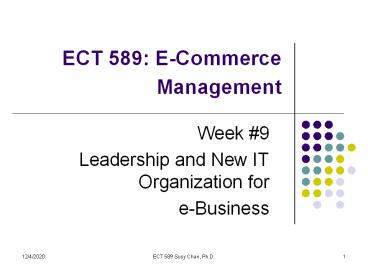ECT 589: E-Commerce Management - PowerPoint PPT Presentation
Title:
ECT 589: E-Commerce Management
Description:
Develop a High-Performing IS Team. Leadership skills/style of the CIO and the IS team ... Practice a range of leadership styles in the IS group. Build team's ... – PowerPoint PPT presentation
Number of Views:137
Avg rating:3.0/5.0
Title: ECT 589: E-Commerce Management
1
ECT 589 E-Commerce Management
- Week 9
- Leadership and New IT Organization for
- e-Business
2
Agenda
- Market News
- Planning for Emerging Technologies (cont.)
- Leadership
- Building the New IT organization
- General Motor Case
- Week 10 Guest Lecture
- Week 11 Final Project Presentation
- Source Broadbent Kitzis, The New CIO Leader,
2005.
3
Leadership vs. Management
- Leadership is about change and influencing others
to change requires vision, strategy,
inspiration, and passion. (charisma?) - Management is about execution and control
planning, organizing, control, and analysis. - Adaptive change vs. technical change
4
The Elements of Leadership
- Vision
- Communication
- Relationship building (functional vs.
relationships) - Building political capital (politicalknowing
your context, your environment, and when to
concede a point to win support for some long-term
position.) - Emotional intelligence self-awareness,
self-management, social awareness (empathy),
social skills
5
CIO Leading Through Influence
- Influence vs. formal power base
- Personality types (Carl Jung
- Myers-Briggs Type Indicator (E/I, S/N, T/F, J/P)
- Sample online test www.humanmetrics.com/cgi-win/J
Types2.asp) - MBTI for leadership and team building example
(www.teamtechnology.co.uk/leadership-styles.html
) - Leadership style (Hay/McBer) All styles have
their time and place. - Commanding Follow me because I say so!
- Pacesetting Follow me do what I do.
- Visionary Follow me because I see the future.
- Affiliative Follow me because were in this
together. - Coaching Try doing it this way.
- Democratic What do you think?
6
CIO Leadership Takes Two Forms
- Demand Side (60-90)
- Understand the environment
- Create a vision
- Shape/inform expectations
- Create IT governance
- Integrate business and IT strategies
- by persuasion relationship
- Supply Side
- Communicate IT performance
- Manage enterprise IT risks
- Develop a high-performance IS team
- Build a new IS organization
- formal authority?
7
Traditional IS Responsibilities
DrivingInnovation
Delivering Change
Supporting Infrastructure
8
The Shape of IS Lite
Traditional IS Responsibilities
DrivingInnovation
Embedded in the business units
Outsourced to external service providers
Delivering Change
Supporting Infrastructure
9
Five Key Roles to Retain in IS
- IT leadership
- Architecture development
- Business enhancement
- Technology advancement
- Vendor management
1
Demand Side
Supply Side
DrivingInnovation
2
Embedded in the business units
3
Outsourced to external service providers
Delivering Change
4
Supporting Infrastructure
5
10
Five Critical Roles to Retain
- IT Leadership crucial to the implementation of
IT vision and IT organization transformation - Architecture development essential for ensuring
system links with outsourcers, process-based
work, control standards, and security management - Business enhancement essential for shifting from
a technical to a business orientation and from a
cost-centric to a value-centric focus - Technology advancement introduction of emerging
technologies that will directly support business
goals. - Vendor management important for outsourcing and
capability management (performance monitoring)
11
Develop a High-Performing IS Team
- Leadership skills/style of the CIO and the IS
team - Human skills self-awareness, self-management,
social awareness, and social skills - Task needs clarity of direction, procedures, etc
- Group needs size, structure, coherence, process,
roles, communications - Individual needs empathy, not just technical
skills - Understand staffs personality types
- Practice a range of leadership styles in the IS
group - Build teams human leadership skills
12
Develop a High-Performing IS Team
- New IS Competencies
- Technical
- Business
- Behavioral
- Analyze the competencies needed for IS jobs
- Competency assessment basic, proficient,
advanced, coach - Compare role profiles with individual profiles
- Close competency gaps with training and
recruiting
13
New IS Competencies -- Technical
- T1 Understanding existing systems and technology
- T2 Designing and developing applications
- T3 Applying procedures, tools, and methods
- T4 Integrating systems
- T5 Designing technical architecture
- T6 Understanding emerging technologies
14
New IS Competencies -- Business
- B1 Understanding business practices and
approaches - B2 Understanding business organization,
politics, and culture - B3 Behaving commercially
- B4 Understanding and analyzing the competitive
situation - B5 Managing projects
- B6 Managing change in the business from IT
applications - B7 Planning, prioritizing, and administering
work - B8 Communicating listening and gathering
information - B9 Focusing on customers
15
New IS Competencies Behavioral
- H1 Leading, inspiring, and building trust
- H2 Thinking creatively and innovating
- H3 Focusing on results
- H4 Thinking strategically
- H5 Coaching, delegating, and developing
- H6 Building relationships and teamwork
- H7 Influencing and persuading
- H8 Principled negotiating
- H9 Resolving conflicts and problems
- H10 Being adaptable
16
Hierarchy of Business Value Measures
Revenue growth Return on assets Rev per employee
Business financial value
Business Management
Business operational value
Time to bring a new Product to market Sales from
new products Products/service quality
Dilution of IT trail
Fewer handoffs Ability to cross-sell Supplier
integration
Business process value
Implementation time and cost of new app
IT application business value
IT investment
Infrastructure Availability Cost/transaction Cost
/workstation
IT infrastructure business value
IT Management
IT investment
Time for Business Impact
Source Weill Broadbent, 1998
17
Dashboard for IT Responsiveness
Product Development Effectiveness
Demand Management
Market Responsiveness
Sales Effectiveness
What the Business Watches
Customer responsiveness
Supplier effectiveness
Operational efficiency
Supply Management
Finance Regulatory responsiveness
IT responsiveness
Support Services
HR responsiveness
IT Responsiveness
What CIO Reports to the Business
System Performance
IT support performance
Partnership ratio
IT total Cost ratio
Service-level effectiveness
New project index
New-Projects Index
On budget
Monitor New Initiatives
Customer Care Performance
On time
On-time delivery
Sales cycle index































